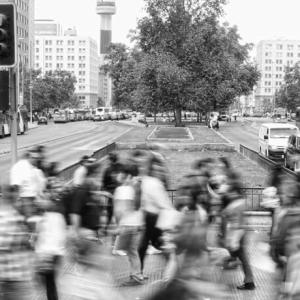
ITS Monday: Edition 23, 2025

ITS Monday is a small, weekly collection of curated content from the worlds of intelligent transport systems, smart mobility, and associated areas.
Included this week, bus tracking for regional NSW, drones for traffic control, designing better bus stops, legal e-mobility in SA, and more.
The article headlines below are:
- Real-time tracking now available on all regional NSW buses
- Scaling V2G: Lessons from distributed solar
- Drone tech keeping roads safe and moving
- Australia’s RideScore program gets international recognition
- South Australia legalises e-Mobility: A step forward, but short of the finish line
- Design better bus stops: Bus stop & interchange guide
- The old traffic math that keeps destroying neighbourhoods
- Examining the Factors Influencing Pedestrian Behaviour and Safety: A Review with a Focus on Culturally and Linguistically Diverse Communities
This week’s articles
Now, scroll down, and see what’s in this week’s edition. Oh, and before you do, be sure check out the quickest way to receive our new content via the subscription box just below …


Real-time tracking now available on all regional NSW buses
“Passengers travelling across regional NSW can now access real-time bus travel information from their smart devices, catching up with technology that commuters in Sydney have been enjoying for years..”
Related iMOVE project:
READ THE ARTICLE
Scaling V2G: Lessons from distributed solar
This article is on LinkedIn, and is written by Steve Letendre, a US energy economist, policy researcher. “Over the past two decades, distributed solar has grown from a technology primarily used in off-grid applications—including, somewhat infamously, by off-grid cannabis growers in California—to a multi-billion-dollar, grid-connected industry delivering low-cost, clean electricity to millions. Looking back, I see key lessons that can guide us as we work to scale Vehicle-to-Grid (V2G) technology.”
Related iMOVE article:

Drone tech keeping roads safe and moving
“The New South Wales Government has deployed a new drone technology that will enable faster responses to emergencies and traffic snarls on key road corridors. In an Australian first, Transport for NSW will be able to fly drones alongside and across highways for remotely piloted scheduled flights, without spotters, enabling them to rapidly respond to incidents near Greater Sydney traffic hotspots.”
Related iMOVE article:
Related iMOVE projects:
READ THE ARTICLE
Australia’s RideScore program gets international recognition
“The top-tier international Journal of Transport and Health has published an evaluation reporting on the highly successful results of the RideScore Active Schools program. The publication this week of the report is an important evidentiary milestone for the program that we believe can help transform the way our kids get to school across the nation.”
Related iMOVE article:
Related iMOVE projects:
- Impacts & community benefits of a regional active travel network
- The TRavel, Environment and Kids (TREK) Study: 15 years on
- Safer cycling infrastructure: Design and policy
- Modelling cycling investments in regional areas

South Australia legalises e-Mobility: A step forward, but short of the finish line
Both a news and an opinion piece, published on LinkedIn by Stephen Coulter, co-founder of Zipidi. “While the move is welcome and long anticipated, it is not without flaws. South Australia has taken some significant strides, but risks falling behind on key safety, design, and transport integration measures.”
Related iMOVE article:
Related iMOVE projects:
- Road use activity data: Cyclists, pedestrians and micromobility
- Impacts of eRideables on the transport task in WA

Design better bus stops: Bus stop & interchange guide
A newly-published guide from the Department of Transport and Planning (Victoria).
“The guide sets out what’s required when designing bus stops and interchanges, and what to consider for safe, accessible and well-integrated public transport infrastructure that supports good decision making. It’s designed for anyone involved in planning or designing public transport infrastructure and should be used alongside relevant legislation and national or state guidance.
The Guide seeks to realise the objectives of Victoria’s Bus Plan like fostering greater accessibility, improved user experience and integration with place.”
READ THE ARTICLE
The old traffic math that keeps destroying neighbourhoods
This is a US-based piece, as you might guess from the use of the term “math” in the title. “If you want to understand how even modern American cities became hostile to human life, don’t start with the political conspiracies; look at the way city planners and road engineers calculate success.”
READ THE ARTICLE
An finally this week, a new academic paper, co-authored by Jie Yang, Nirajan Gauli, Nirajan Shiwakoti, Richard Tay, Hepu Deng, Jian Chen, Bharat Nepal, and Jimmy Li. The abstract:
Pedestrian behaviour and safety are essential components of urban sustainability. They are influenced by a complex interplay between various factors from different perspectives, particularly in culturally and linguistically diverse (CALD) communities.
This study presents a comprehensive overview of the factors influencing pedestrian behaviour and safety with a focus on CALD communities. By synthesizing the existing literature, the study identifies six key groups of influencing factors: social–psychological, cultural, risk perceptions, environmental, technological distractions, and demographic differences. It discovers that well-designed interventions, such as tailored education campaigns and programs, may effectively influence pedestrian behaviour.
These interventions emphasize the importance of targeted messaging to address specific risks (e.g., using mobile phones while crossing the road) and engage vulnerable groups, including children, seniors, and CALD communities. The study reveals that CALD communities face higher risks of pedestrian injuries and fatalities due to language barriers, unfamiliarity with local road rules, and different practices and approaches to road safety due to cultural differences.
This study underlines the importance of developing and promoting tailored road safety education programs to address the unique challenges faced by CALD communities to help promote safer pedestrian environments for all.
READ THE ARTICLEDiscover more from iMOVE Australia Cooperative Research Centre | Transport R&D
Subscribe to get the latest posts sent to your email.

